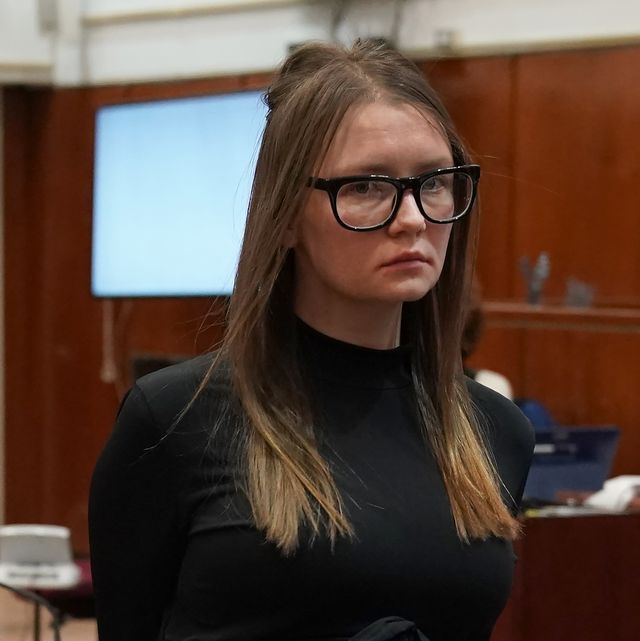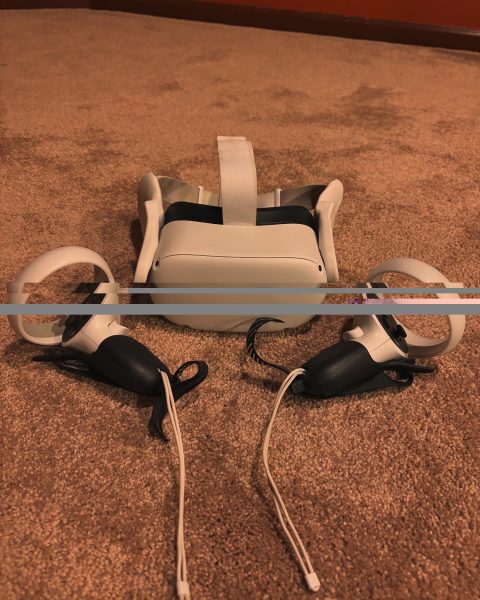New York’s Socialite Is a Fraud
The Case of Anna Delvey
Anna Delvey in Court (Cosmopolitan) https://www.google.com/url?sa=i&url=https%3A%2F%2Fwww.cosmopolitan.com%2Fuk%2Freports%2F
Anna Delvey wasn’t always as crazy as she seems. Her story did not begin the moment she committed her first crime. Her story started way before that, which is a fact that most people choose to ignore. She was born into a working-class family on January 23, 1991. Her dad was just your daily truck driver and her mom owned a small convenience store. She grew up in a working-class life and ended up getting relocated when she was 16 years old for her dad’s career. Her dad managed to open an extremely successful HVAC business and her mom decided to stay as a stay-at-home mom, after having to sell the convenience store. At the time of the relocation, her family enrolled her into a private catholic German school, her peers now say that when they knew her she was quiet. They also bring up the point that she struggled a lot with learning proper German grammar. During the relocation, she found that she was comforted by fashion trends in all sorts of magazines. This was her safe place as she was passed around through friend groups at such a hard age. She finally got out of the Catholic German school and enrolled in an art school in London but shortly after dropped out. Her parents supported her in her move to Paris to pursue her dreams of interning at a fashion magazine. Her parents support often included paying her rent for her to take that stress off her shoulders. After being convicted, her parents counterpointed one of her statements. She told people that she changed her last name to honor her mother’s maiden name. Her parents were able to conclude that the name has never been seen in their family and that Delvey had indeed made it up on her own.
Anna Delvey, the new name she took on as she discarded the surname Sorokin, put on the facade of New York’s most influential socialite. She pretended to be a wealthy heiress and often bragged about the brands of clothes she was wearing. From those around her, she would be described as entitled and mean especially to those doing service for her. A former friend of her’s mentioned that “when an elevator opened, she would not wait for other people to get off”. With no actual money of her own, she would have to take advantage of those around her to keep up appearances. As she made appearances outside of parties with important guests, she would talk to them and start befriending those around her for her benefit by inviting them to her party even if they barely knew each other. Delvey would then rely on the people she would meet for expenses such as shopping trips, lavish transportation, vacations, and dinner and drinks.
One of Delvey’s most notable scams was when she had met an art collector at a dinner party and learned that he was planning on going to Venice Biennale. She asked him if she could join him and he agreed, paying for her flight and hotel stay with the assumption that she could pay him back another day. Weeks after their trip had gone by and she still had not paid him back yet. She claimed that she forgot about the trip altogether, thus not feeling the need to reimburse. He then became suspicious after he was contacted by a restaurant assuming he was friends with Delvey. They after him how they could get in contact with her because she had never paid for her meal. As he thought about the situation more, he realized that she only saw her make payments in cash and sleep in hotels. As time went on, he was eventually paid back by a Venmo account with an unfamiliar name and he immediately blocked her, never speaking to her again.
Not only was Delvey stealing from people, but she was stealing from banks as well. She used Microsoft Word to create fake bank statements and other financial documents to make it seem like she had more money than she did as she would often claim that she could not access the money in her bank because it was kept in a trust, using this as “proof”. In November 2016, Delvey submitted false documents as a part of a loan application for $22 million, but the bank refused to extend her credit when she failed to provide the source of her assets. Because of this, she applied for a loan from a different bank and they agreed to consider her application if she paid $100,000 t0 cover legal expenses relating to the application. Because she could not afford this, Delvey went back to the first bank on January 12, 2017, and convince them to grant her a temporary overdraft facility for $100,000 and promised to repay it. The director arranged to verify her assets by meeting with her banker in Switzerland, but because this was all a lie, she withdraw the loan application and went back to the second bank using the overdraft and spending it on luxury clothes, electronics, and a personal trainer as well as $800 hair highlighting and $400 eyelash extensions.
After scamming people, businesses, and banks out of hundreds of thousands of dollars several times, Anna Delvey was finally arrested on October 3, 2017, in a sting operation planned by a police officer working with the Manhattan District Attorney’s office and Delvey’s former friend, Rachel Williams. Later that month, Sorokin was indicted on two counts of attempted grand larceny in the first degree, three counts of grand larceny in the second degree, one count of grand larceny in the third degree, and one count of misdemeanor theft of services. On December 18, 2018, Delvey rejected a plea deal that offered three to nine years in prison and her trial began on March 20, 2019. Delvey’s defense attorney arranged for a stylist to style her outfits for her court appearances. During her trial, Devley’s main defense was that all along she had intended to repay her debts through publicity on Instagram and described her as an entrepreneur, and even went as far as comparing her to Frank Sinatra because they both created a “golden opportunity” in New York.
On April 25, 2019, after two days of deliberating, the jury found Delvey guilty of eight charges, including grand larceny in the second degree, attempted grand larceny, and theft of services and she was found not guilty of one count of attempted grand larceny in the first degree and one count of larceny in the second degree. Before she was sentenced, Delvey said that “I’d be lying to you and everyone else and myself if I said I was sorry for anything” clearly telling the world that she does not regret her crimes. She was sentenced to 4-12 years in prison on May 9, 2019, and was fined $24,000 and ordered to pay $199,000 in restitution.
Delvey knew well that to play the part of the wealthy socialite, she would also have to look the part. However, to the average eye, photos of the outfits she wore would not support this statement. Although she was often in designer clothing, she would usually dress it down into simple outfits consisting of hoodies, workout pants, and sneakers. Many people do not associate this causal and laid-back style with that of a wealthy heiress. While some “New York rich girls” are considered to be among the best-dressed women, most dress in the same style that Delvey did, which is why she got away with her act for so long. When Delvey’s hotel room was investigated, it was found that her room was overflowing with bags from brands like Supreme and Acne, which are staple brands for many young people with wealth in New York City. Rachel Williams, a Vanity Fair staffer, described Delvey’s closet as a checklist of best-selling luxury items, as opposed to items with any sense of personal expression. This was a fact that many believe was almost completely ignored by the costume team for Inventing Anna, a popular Netflix miniseries based on the case of Anna Delvey. Lyn Paola, the head costume designer for this show, claimed that she wanted to make the outfits in the show as close as possible to Delvey’s real outfits whenever possible. According to many viewers, this plan wasn’t executed as well as Paola initially wanted. “I think they went a little over the top with her outfits,” claims Brielle Yencha, a watcher of Inventing Anna who is also familiar with a lot of Delvey’s real looks. This makes sense, though, after Paola came out and said that she was not a personal fan of Delvey’s fashion in real life. “Our Anna needed to look a little more elevated than the real Anna,” stated Paola.
There were certain times, though, when the costume designing team was able to properly implement certain aspects of Delvey’s real wardrobe into the character. For example, one of the staples in her real wardrobe was a black Alaïa knit dress, which the costume design team was able to find at a consignment shop. The dress was two sizes too big, however, for actress Julia Garner, who played Anna Delvey, so they had to alter the dress. The show was also able to mimic Delvey’s courtroom fashion quite well, which it often receives praise for. The real Delvey had her outfits during her trial styled by Anastasia Walker, a former Glamour Magazine staffer who also styled celebrities like Courtney Love and G-Easy. It was alleged that she always wore designer brands like Miu Miu, Yves Saint Laurent, and Michael Kors, which were also brands that the series used to style Delvey’s court looks. Her “iconic” black choker, which she was always seen wearing, both in and out of court, was recreated by the show as well. This part of Delvey’s style often clashes with her chameleon-like styling tricks that helped her blend in with wealthy socialites. Her choker was a style mostly reminiscent of the 60s and 80s fashion and was not as modern as most of her other clothes, nor as popular. It is the small fashion decisions, like this, that make Delvey’s fashion all the more interesting because of how out-of-character it seems.
For the most part, though, the show focused more on making Delvey’s looks extravagant and unrealistic to her true fashion. Paola even admits to channeling other muses that weren’t the real-life Delvey, like Grace Kelley in Alfred Hitchcock’s To Catch a Theif, in the scene where Delvey first arrives in Ibiza wearing a designer scarf wrapped around her head. This is a look that the real Delvey was not noted to have worn, and probably never would have, making it similar in that aspect to the other costumes in the show. Despite this, Paola still acknowledges that the real-life closet of Anna Delvey was what gave her the ability to blend in as a wealthy heiress and to commit the crimes she did.
Sophia Birnbaum, Grade 12. Her hobbies and interests include listening to and writing music, playing tennis, spending time with her friends and family,...
Odi Dibor. Grade 12. Interests/hobbies include Executive Council, Red Cross Club, Mini-THON, Key Club, National Honors Society, playing tennis, traveling,...
James Peuplie, Grade 12. Interests/hobbies include cheerleading, watching my dogs, and going out with friends on the weekends. James plans to attend Indiana...





